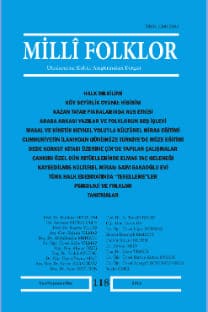BİYOGRAFİ: ETNOGRAFLAR İÇİN YÖNTEM VE ÖNERİLER
Biography: Method and Suggestions to Ethnographers
___
- Augé, Marc. Yaşsız Zaman – Kendi Etnolojini Yapmak. (çev. Ö. Naldemirci) İstanbul: YKY, 2017.
- Berntsen, Dorthe ve Annette Bohn. “Kültürel Yaşam Senaryoları ve Bireysel Yaşam Öyküleri”, Zihinde ve Kültürde Bellek. (haz. P. Boyer ve J.V. Wertsch) (çev. Y. Aşçı Dalar) İstanbul: Türkiye İş Bankası, 2015:79-105.
- Bourdieu, Pierre. Pratik Nedenler. (çev. H. Uğur Tanrıöver) İstanbul: Hil Yayınları, 2006.
- Bourdieu, Pierre. Bir Otoanaliz İçin Taslak. Çev. M. Erşen. İstanbul: Bağlam, 2012.
- Boyer, Pascal. “Anılar Ne İşe Yarar? Hatırlamanın Biliş ve Kültürle İlgili İşlevleri”, Zihinde ve Kültürde Bellek. (haz. P. Boyer ve J.V. Wertsch) (çev. Y. Aşçı Dalar) İstanbul: Türkiye İş Bankası, 2015:5-36.
- Caunce, Stephen. Sözlü Tarih ve Yerel Tarihçi. (çev. B. B. Can ve A. Yalçınkaya) İstanbul: Tarih Vakfı Yurt Yayınları, 2001.
- de Pina-Cabral, Joao. “History of Anthropology and Personal Biography”, Anthropology Today, Vol.24, No.6, 2008:26-7.
- Draaisma, Douwe. Yaşlandıkça Hayat Neden Çabuk Geçer. (çev. G. Koca) İstanbul: Metis Yayıncılık, 2012.
- Draaisma, Douwe. Sıla Hasreti Fabrikası. (çev. D. Tunç) İstanbul: YKY, 2016.
- Ellis, Carolyn. The Ethnographic I: A Methodological Novel About Autoethnography. Walnut creek, CA: Alta Mira Press, 2004.
- Ellis, Carolyn, Tony E. Adams ve Arthur P. Bochner. “Autoethnography: An Overview”, Historical Social Research, Vol. 36, No. 4(138), 2011:273-290. Erişim: http://www.jstor.org/ stable/23032294, indiriliş: 29.12.2015.
- Fabian, Johannes. Zaman ve Öteki. (çev. S. Budak) Ankara: Bilim ve Sanat Yayınları, 1999.
- Fischer, Micheal M. J. ve George E. Marcus. Kültürel Bir Eleştiri Olarak Antropoloji. (çev. B. Cezar) İstanbul: Koç Üni. Yayınları, 2013.
- Gawthorpe, Ann. Biyografi ve Anı Yazarlığı. (çev. Z. H. Akman) İstanbul: Optimist, 2013.
- Geertz, Clifford. Gerçeğin Ardından. (çev. U. Türkmen) Ankara: Dipnot, 2011.
- Kara, Çiğdem. “Terzi Bekir Dülger”, Acta Turcica – Çevrimiçi Tematik Türkoloji Dergisi, Y. 1., S. 2/2, 2009:151-167.
- Langness, L. L. ve Gelya Frank. Lives – An Anthropological Approach to Biography. California: Chandler & Sharp Pub. 1985.
- Lässig, Simone. “Modern Tarihte Biyografi – Biyografide Modern Tarihyazımı”, Otur Baştan Yaz Beni içinde. (çev. C. Özkılıç) (haz. A. Kırmızı), İstanbul: Küre Yayınları, 2013:29-58.
- Lohmann, Roger Ivan. “Introduction: Biographies of Antropologists As Anthropological Data”, Reviews in Anthropology, Vol. 37, 2008:89– 101, DOI: 10.1080/00938150802040444.
- Malinowski, Bronislaw. A Diary in the Strict Sense of the Term. London: The Athlone Press, 1989.
- McBeth, Sally. “Myths of Objectivity and the Collaborative Process in Life History Research”, When They Read What We Write içinde. (ed. C. B. Bretell) Connecticut: Bergin & Garvey, 1993:145-162.
- Mead, Margaret. Blackberry Winter – My Earlier Years. New York: William Morrow & Company, Inc. 1972.
- Plummer, Ken. “The Call of Life Stories in Ethnographic Research”, Handbook of Ethnography içinde. (ed. P. Atkinson, A. Coffey, S. Delamont, J. Lofland and L. Lofland), London: Sage Publication, 2005:395-406.
- Pultar, Gönül ve Serpil Aygün Cengiz. Kardeşli- ğe Bin Selam. İstanbul: Tetragon, 2003.
- Reed-Danahay, Deborah. “Autobiography, Intimacy, and Ethnography”, Handbook of Ethnography içinde. (ed. P. Atkinson, A. Coffey, S. Delamont, J. Lofland and L. Lofland) London: Sage Publication, 2005: 407-25.
- Roediger III, Henry L., Franklin M. Zaromb ve Andrew C. Butler. “Kolektif Belleğin Şekillendirilmesinde Tekrarlanan Hatırlamanın Rolü”, Zihinde ve Kültürde Bellek. (haz. P. Boyer ve J.V. Wertsch) (çev. Y. Aşçı Dalar) İstanbul: Türkiye İş Bankası, 2015: 175-216.
- Thompson, Paul. Geçmişin Sesi. (çev. Şehnaz Layıkel) İstanbul: Tarih Vakfı Yurt Yayınları, 1999.
- Turner, Edith. Heart of Lightness. New York: Berghahn Books, 2006.
- Türesay, Özgür. “Tarihyazımı ve “Biyografinin Dönüşü”, Halil İnalcık Armağanı – I – Tarih Araştırmaları içinde. [y.y.]: Doğu Batı Yayınları, 2009: 329-349.
- Williams, Helen L. ve Martin A. Conway. “Otobiyografik Anı Ağları”, Zihinde ve Kültürde Bellek. (haz. P. Boyer ve J.V. Wertsch) (çev. Y. Aşçı Dalar) İstanbul: Türkiye İş Bankası, 2015: 43-77.
- ISSN: 1300-3984
- Yayın Aralığı: 4
- Başlangıç: 1989
- Yayıncı: Geleneksel Yayıncılık Eğitim San. Tic. Ltd. Şti.
ETNOGRAFİ’DEN NETNOGRAFİ’YE SANAL ORTAMDA KURŞUN DÖKME: “SEN Bİ KURŞUN DÖKTÜR”
TÜRKİYE’DE SOSYAL MEDYANIN M/İZAHI: SOSYAL PAYLAŞIM AĞLARINDAKİ DENEYİMLERİN KARİKATÜRLERE YANSIMASI
ONUNCU YILINDA SOMUT OLMAYAN KÜLTÜREL MİRAS LİSTELERİ: GÖRÜNÜRLÜK, DEĞERLİLİK VE GÜVENİRLİK
SEÇKİNLEŞTİRİLEN EL SANATLARI VE GELENEĞİN SINIRLARI: OLGUNLAŞMA ENSTİTÜLERİ ÖRNEĞİ
HEKİM FOLKLORUNDA STEREOTİPLERİN LAKAPLARI ŞEKİLLENDİRMESİ VE FIKRALARA YANSIMALARI1
BİYOGRAFİ: ETNOGRAFLAR İÇİN YÖNTEM VE ÖNERİLER
